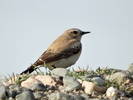search
classification
|
basic information
|
video
|
reports |
Desert Wheatear
Oenanthe deserti (Temminck, 1829)

|
 male
|
|
|
2020-03-22
Bishkek |
© Philippe Campeau
|
|
Description
The Desert Wheatear is a small bird 18-20 grams in weight. The upper parts of the male in summer are buff. The forehead, crown and uppertail are white. The wings are blackish, the flight feathers are black with the white bases. The cheeks, throat and the flanks of the neck are black. The black on the face and throat extends to the shoulders, and there is distinct white superciliary stripe. The underparts are white with a buff tinge on the breast. The black color at the female replaced by the brown one. The female is greyer above and buffer below and has no black on the throat, and in the winter plumage the black on the throat of the male is obscured by white tips. Juveniles are similar on female but have the light spots on the back and the dark spots on the abdomen. The best character, in both sexes at all ages, is that the entire tail is black to the level of the uppertail coverts.
Biology
The Desert Wheatear is common, in places rare breeding migrant. It inhabits the sand desert with scarce vegetation, rare the saline deserts and the stone deserts with clay coombs up to 400-1000 m. These countries are used by Desert Wheatear on migration too. It appears in March – early April. Breeds in separate pairs not close one to another. The nest is built in the uninhabited burrows of rodents, among the roots, under the wind fallen saxaul trees, between the stones, under the sage-brush, or in the clay precipices at 0.9-2.8 m above the ground. The nest is mealy and cumbersome construction. It is built from the dry grass and leaves, sometimes the panicles of cane, the vegetal fuzz and the feathers; and is lined either with the hair and feathers, or with the thin grass and bast, or with both hairs and grass. The clutches of 3-6 eggs is in the end April – end May. Probably only female incubates for 14-16 days. Both parents feed hatchlings. Juveniles fledge at 13-14 days old in end May – end July. Two broods per year are probable but not proved. Autumn migration is most in September, the latest birds recorded in the end of October - early November.
References
Э.И.Гаврилов. "Фауна и распространение птиц Казахстана". Алматы, 1999. Gavrilov E. I., Gavrilov A. E. "The Birds of Kazakhstan". Almaty, 2005. "Жизнь Животных" том 5. Птицы. Москва. "Просвещение", 1970. А.Ф.Ковшарь "Певчие птицы". Алма-Ата, "Кайнар", 1983.













